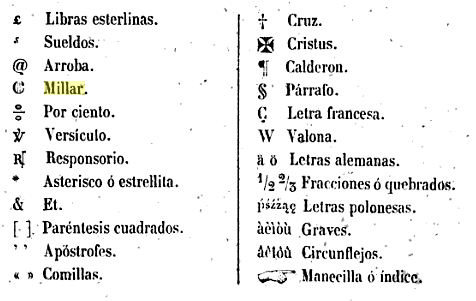Date: Mon, 9 Nov 2015 13:32:17 -0800
I took a quick look to see if I could find any other examples, which
probably confuses things more.
Take a look at this book, which describes millar symbols: 20ↄ and 40JJ
(approximately) for 20 thousand and 40 thousand.
Another document says the calderón (i.e. pilcrow ¶) can be used for
thousands.
https://books.google.com/books?id=MtxGAAAAIAAJ&dq=%22denotar%20el%20millar%22&pg=PA214#v=onepage&q=%22denotar%20el%20millar%22&f=false
Ken
On Mon, Nov 9, 2015 at 11:32 AM, Andrés Sanhueza <peroyomaslists_at_gmail.com>
wrote:
> Hello. I was looking for info in Spanish about some rare punctuation
> symbols and found one in some Spaniard XIX century books (vía Google books)
> I haven't seen referenced anywhere. It was called "millar", which
> translates somewhat like "thousand". It seems that it had at least four
> glyph variants, yet the quality of the scans make it a bit difficult to
> reproduce exactly.
>
> [image: Imágenes integradas 1]
>
> A sample from "Manual del cajista" by José María Palacios (1845). It says
> (poorly translated):
>
> The millar ([symbol]) o millaron as it is commonly called) is the
>> abbreviation for the zeros, when one types amount of a thousand: so,
>> with a single numeral and a sign of these it can be read thousands.
>
>
> The description is not very clear, but I understand that the sign is an
> abbreviation of the three zeros that comes in one thousand. so, instead of
> writing 40.000, one can write 40[symbol].
>
> In the text the sing is given the look of a turned C with a lighting bold
> in it, but I can be wrong.
>
> [image: Imágenes integradas 2]
>
> Another sample from "Gramática castellana fundada sobre principios
> filosóficos" by Francesc Pons i Argentó (1850), with a more
> straight-forward description.
>
> Among counters the same name is given to each of these signs [symbol1],
>> [symbol2], [symbol3] to denote thousand. So 20[symbol1] is read twenty
>> thousand, 30[symbol2], thirty thousand, 40[symbol3], forty thousand.
>
>
> Now there's three glyphs variants. One is an stand-alone turned C. Other
> is a turned C with two bars as an overlay. The other looks like two f's
> turned 180°, or two j's with an small bar.
>
> Another sample from "Manual de la tipografia española, ó sea, El Arte de
> la imprenta" by Antoni Serra i Oliveres (1852).
>
> [image: Imágenes integradas 4]
> In this one, the millar looks like an straight C with two overlay bars.
> The other symbols mentioned look like familiar ones, (the "sueldos"
> (salaries) one looks like an small s in superscript. I guess is just an
> abbreviation. I'm a bit confused with the letters with diacritics, but
> don't seems anything unknown).
>
> Anyone has more insight about this?
>


